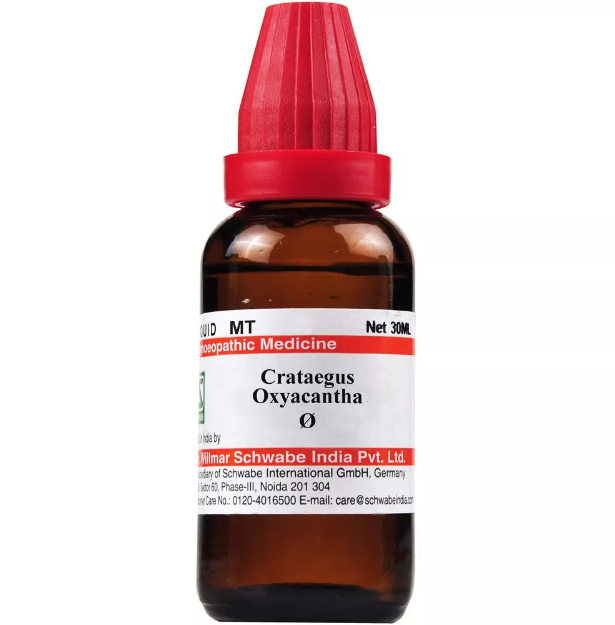CRATAEGUS OXYACANTHA Q, 6C, 12C, 30C, 200C, 1M, 10M USES AND SYMPTOMS
 CRATAEGUS OXYACANTHA
CRATAEGUS OXYACANTHA
(Hawthorn Berries)
Crat.
Causes giddiness, lowered pulse, air hunger, and reduced blood pressure. Acts on heart muscle as a cardiac tonic without affecting the endocardium. Used for myocarditis, heart irregularities, insomnia in aortic sufferers, anemia, edema, and chilliness. Reduces high arterial tension and serves as a sedative for irritable patients with cardiac issues.
Treats chronic heart disease with extreme weakness and irregular heart action. Alleviates general swelling, nervousness, pain at the back of the head and neck, typhoid collapse, bowel hemorrhage, cold extremities, pallor, irregular pulse, and breathing difficulties. Relieves chest pressure below the clavicle, dyspepsia, and nervous prostration linked to heart failure. Useful at the onset of heart disease following rheumatism and for arteriosclerosis by potentially dissolving arterial deposits.
Head: Causes apprehension, despondency, nervousness, irritability, pain at the back of head and neck, mental dullness, conjunctival irritation, and nasal discharge.
Urinary: Used for diabetes, especially in children.
Heart: Addresses cardiac dropsy, fatty degeneration, aortic disease, extreme dyspnea on slight exertion without a significant pulse increase, pain around the heart and under the left clavicle. Treats flabby heart muscles, cough, heart dilation with weak first sound, accelerated and irregular pulse, valvular murmurs, angina pectoris, chilliness, and cyanosis of fingers and toes, exacerbated by exertion or excitement. Supports the heart during infectious diseases.
Sleep: Helps with insomnia in aortic patients.
Skin: Treats excessive perspiration and skin eruptions.
Modalities: Symptoms worsen in a warm room and improve with fresh air, quiet, and rest.
Relationship: Related to Stroph-h., Dig., Iber., Naja, Cact.
Dose: Use fluid extract or tincture, one to fifteen drops, over a period for best results.
SYMPTOMS OF CRATAEGUS OXYACANTHA
Heart-Related Symptoms:
Myocarditis
Irregular heart action
Heart failure
Chronic heart disease with extreme weakness
Collapse of typhoid
Cardiac dropsy
Fatty heart degeneration
Aortic disease
Extreme dyspnea on slight exertion
Pain in the heart region and under the left clavicle
Weak first heart sound
Accelerated, irregular, feeble, intermittent pulse
Valvular murmurs
Angina pectoris
Cyanosis of fingers and toes
Nervous System Symptoms:
Nervousness
Pain at the back of head and neck
Insomnia in aortic sufferers
Apprehension and despondency
Mental dullness
Irritability
Conjunctival irritation and nasal discharge
Skin Symptoms:
Excessive perspiration
Skin eruptions
Cutaneous chilliness
Gastrointestinal Symptoms:
Dyspepsia
Nervous prostration with heart failure
Circulatory Symptoms:
Edema (general swelling)
Cold extremities
Pallor
High arterial tension
Urinary Symptoms:
Diabetes, especially in children
Additional Symptoms:
Hemorrhage from bowels
Painful chest pressure below the clavicle
Modalities:
Worse: In a warm room.
Better: In fresh air, quiet, and rest.
selection of the potency
Individualization:
- Homeopathy is based on the principle of treating the individual, not just the disease. The unique symptoms and characteristics of the person are crucial in determining the most suitable potency.
Intensity of Symptoms:
- The intensity of the symptoms guides the choice of potency. If the symptoms are intense and acute, a lower potency (e.g., 6C, 30C) might be considered. For chronic conditions with less intensity, higher potencies (e.g., 200C, 1M) may be appropriate.
Sensitivity of the Patient:
- Some individuals are more sensitive to homeopathic remedies, while others may require higher potencies. The practitioner considers the patient’s sensitivity when selecting the potency.
Acute vs. Chronic Conditions:
- Lower potencies are often used for acute conditions, while higher potencies may be considered for chronic or long-standing issues.
Previous Response to Potencies:
- The patient’s response to previous homeopathic treatments helps guide the choice of potency. If a particular potency has been effective in the past, it may be repeated or adjusted as needed.
Vital Force and Susceptibility:
- Homeopathy views illness as a disturbance in the vital force. The practitioner assesses the patient’s overall vitality and susceptibility to determine the appropriate potency.
Aggravation or Amelioration:
- The direction of the symptom response (aggravation or amelioration) after taking a remedy can influence the choice of potency.
Miasmatic Considerations:
- In classical homeopathy, the concept of miasms (inherited disease tendencies) is considered. The practitioner take this into account when selecting the potency.
Practitioner Experience:
- The experience and preference of the homeopathic practitioner play a role. Some practitioners may have success with certain potencies based on their clinical experience.
SAFETY INFORMATION
- Do not exceed the recommended dose by physician
- Keep out of the reach of children
- Store in a cool dry place away from direct sunlight
- Maintain half an hour gap between food/drink/any other medicines and homoeopathic medicine
- Avoid any strong smell in the mouth while taking medicine e.g. camphor, garlic, onion, coffee, hing
Medicine images use for reference only selection of homeopathic medicine depends on the individual’s specific symptoms and overall constitution. Moreover, homeopathy is a holistic system of medicine that treats the individual as a whole. In addition to addressing the physical symptoms, it takes into account the emotional and mental state of the person. Consequently, it’s crucial to consult with a qualified homeopathic practitioner for personalized treatment.
The information provided on this website is intended solely for educational purposes. Always seek the advice of your physician or other qualified health provider.
